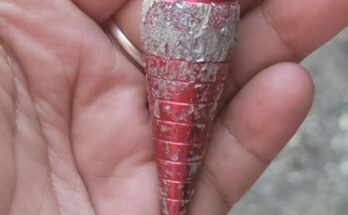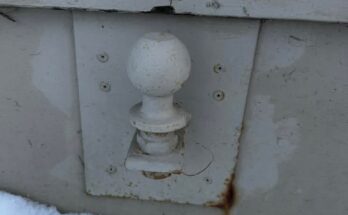Some collision mitigation systems are not-always-jokingly referred to as overhead sign detectors. Overhead obstacles, particularly metal signs, have been known to trigger collision mitigation system alerts causing significant consternation for drivers.
One component of such systems is a forward-looking radar unit. These are used to detect the presence of metallic objects and to record the distance from the radar source. These radar units emit narrowly focused beams of radio waves in a forward direction.

Even if the radar unit is only slightly misaligned — out by only a few degrees — the narrow beam could be well off its intended target a few hundred feet in front of the truck up, down, or laterally.
These units are aligned and calibrated at the factory when they are installed, but any time an ADAS-equipped truck incurs front-end damage resulting from a collision — or even minor damage resulting from a curb strike — the radar unit mounted in the bumper could be damaged or become misaligned.
Mechanics and technicians repairing or doing body work on trucks with advanced driver assistance systems (ADAS) need to be aware of the problems that can arise if the work isn’t done to the manufacturer’s exact specifications.
“One thing you want to pay a lot of attention to, especially with these radars, is the mounting of the radars, and the brackets that hold the radars,” says Chuck Brodie, senior fleet service engineer, ZF Group. “It’s very important that these radars are pointing the right way.”
Brodie was speaking on a Study Group panel discussion on ADAS Recalibration and Repair at the annual general meeting of the American Trucking Associations’ Technology & Maintenance Council earlier this year.
Brodie noted ZF’s radars have some small level of tolerance — plus or minus two degrees, which isn’t much — but technicians do have some latitude. Still, Brody gets plenty of calls from fleets having trouble calibrating their units.
“They will get a radar alignment fault, and the unit won’t complete the alignment. Naturally, they think there’s something wrong with the radar. After we work with them, we often find the bracket was bad, or the front frame cross member was bad,” he notes. “Obviously, any bad bracket probably needs to be replaced, but the technicians can waste a lot of time struggling to find the cause of the problem.”
Additionally, Brodie says the wiring harness and connectors can be compromised in a collision, which in time could lead to faults and issues you have to trace back through the system.
“Looking a little bit closer, you may notice that in the collision, the component wasn’t necessarily broken, but you might see the wiring was disturbed, or the harness,” he suggested. “That may not present a problem today, but that may come back after we’ve repaired it and put it back on the road.”
So, don’t just check for bad mounting brackets. Other components upstream of the unit could be damaged as well.
Interestingly, modern radar units can tell you when they are out of alignment, but they have to be driven to do so. Brodie said if the truck is towed from the collision scene, the radar unit will not have had the opportunity to detect a fault. But it may throw a fault code after it has been put back in service.
Most of today’s radar systems are self-aligning, but some makes and models have some adjustments available. The manufacturer’s data sheets and repair procedures will describe the process, but in most cases, the truck has to be driven for a few miles for the system to complete the alignment.
Aligning the radar should be completed before the truck is returned to service lest the faults start showing up after the repairs are complete. This, of course, can have negative consequences for the driver, either with false warnings or incessant alerts about alignment faults.
In other words, you can’t just bolt the radar unit back on and send the truck down the road.

Windshield-mounted camaras and lasers
Alignment and calibration of windshield-mounted cameras and laser systems is equally important, especially in stacked systems where input from radars and cameras is used to determine lane position.
“A misaligned camera, for example, will prevent the system from functioning properly,” says Hector Flores, director of warranty and equipment optimization at Knight-Swift Transportation. “If the proper steps aren’t taken when repairing the systems, you decrease your chances of success, and that could impact driver satisfaction with the performance of the ADAS system.”
Flores says his company replaces hundreds of windshields every year. He has developed standard procedures for his staff when replacing the glass and aligning the lane departure warning system cameras. But when work is done at outside shops, or even a roadside emergency repair, he’s at the mercy of the technician doing the work.
If it’s an auto-glass installer with limited experience with ADAS equipment, Flores suggests it might be better to wait until the truck is back in qualified hands before reinstalling the camera system.
“If the LDW [lane departure warning] camera is not included with the replacement glass, you will have to follow the OEM or supplier recommendations on where and how the camera is to be installed,” he says.
Auto-glass shops offering OEM replacement will have glass with imprints to guide installation, but some aftermarket glass may not. That’s when you have to get out the measuring tapes.
Proper placement is critical
Brodie recalled a situation where he had been called to a fleet to diagnose a problem with the lane departure system. He found the camera had been mounted sideways, 90 degrees off-axis, on the windshield. When he asked the fleet manager why it was mounted sideways, he was told they were trying to make room on the windshield to mount a driver-facing camera as well.
“That’s not the way this technology works,” he told the manager.
“Mounting is so important,” he emphasized. “ZF provides templates to make the installation as easy as it can be. Find the correct templates and use them. Always install the cameras as per your supplier’s instructions.”
Software and hardware compatibility
As ADAS systems have evolved, multiple generations of the technology have emerged, along with the requisite software upgrades and updates. Nick Broyles, ADAS R&D director at Bendix Commercial Vehicle Systems, urged audience members to be vigilant when replacing components and recalibrating the systems.
“To have a properly working system, you do need to have the system properly calibrated and properly mounted,” he stressed. “Bendix has service data (SD) sheets for all their systems and components, and each generation of radar would have its own SD sheet with all the information needed to repair or calibrate that component.”
All ADAS suppliers have something similar for their systems, but Broyles stressed it’s important that any updates or upgrades available, particularly with older models of camera or radar, be installed prior to beginning the calibration process.
During the panel discussion, much of the conversation centered around specific brands, such as Bendix or Daimler’s Detroit Assurance. Obviously, fleets will be going back to their suppliers for advice and guidance on repairing such systems, but it was mentioned that technicians working on multiple systems may need some brand-specific refresher training.
And techs new to ADAS repair and calibration need to be eased into it rather than thrown into the deep end with nothing more than a manual to guide them.

Training and technical resources
Rodger Pitts, fleet service manager at The Peterbilt Store in York, Penn., has been training ADAS technicians for years. He recommends starting tech training with online resources before moving on to working equipment, and then, in an observer role alongside an experienced technician.
“I’ve always started them off training online to get as much knowledge as I could, and then I hooked them up with a trained technician who would walk them through some of the hands-on processes in the shop,” he said. “Learning to trouble shoot the systems takes time but learning how to install and calibrate has to come first.”
The key is to combine online learning with practical, supervised experience to develop technician expertise in ADAS system repair and calibration.
Contact your system supplier for more information on training materials and programs. Additional ADAS training resources are available through TMC, with Recommended Practice 548 – Technician Training for Advanced Driver Assistance Systems.
Interesting questions
Two questions came up during the Q&A session that are worth mentioning. One fleet manager asked if the tractor air suspension ride height or the cab air suspension could affect camera alignment and therefore the proper function of the LDW or emergency braking system.
The answer was…probably not.
“We know commercial vehicles have a lot more movement than passenger cars,” said Bendix’s Broyle. “We validate these systems with that in mind, but if you dump the rear suspension and dump the cab suspension, that amount of pitch could cause some sort of misalignment. But typical cab movement while driving a properly operated and maintained vehicle won’t be an issue.”
The other question related to pulling parts off parked trucks to keep newer trucks running. ZF’s Brodie said the company has encountered issues related to system compatibility, software updates, etc., with older components. He said ensuring the software is compatible usually resolves that problem.
And then there’s the issue of clever drivers discovering ways to thwart or disable the systems.
“We obviously need to discourage that behavior, but it’s certainly something to look for when diagnosing problems and fault codes,” said Knight-Swift’s Flores. “It happens all the time.”


